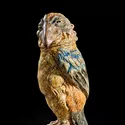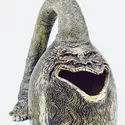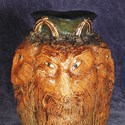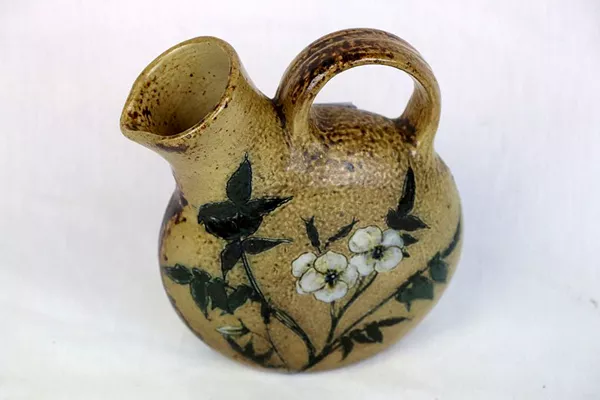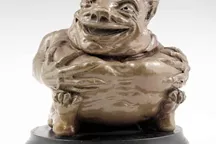This is how Holbrook Jackson described his first visit to a small pottery dealership situated in Brownlow Street, Holborn, in 1910. He was not the first, nor the last, to be captivated by the eccentric creations of the four Martin Brothers.
Production began in 1873 with a kiln at the family home in Fulham and expanded in 1877 with a move to a disused soap works on the canal on Havelock Road in Southall, where sporadic production would continue until 1923.

The men, their birds and their beards in the workplace. A c.1910 photograph on wood depicting (from left to right) Walter, Robert and Edwin Martin.
Eldest brother Robert Wallace modelled the figures, Walter fired the kiln, mixed the glazes and threw the pots, Edwin was chiefly the decorator while youngest brother Charles ran the City shop – badly. Wildly eccentric, even by the standards of his siblings, he hated to part with any of the wares, hid the best of them under the floorboards, and turned away many a prospective customer. Eventually, the shop burned down, the brothers lost their stock, and Charles his sanity.
There was a less-than-commercial approach to production. A single high-temperature kiln was fired just once a year without protective saggars which meant every pot was in direct contact with the flames.
The result was a very unpredictable output (on one occasion, only one good pot emerged from an entire year’s work) but the pieces that did emerge were often Victorian art pottery at its best – a vast range of beautifully formed and decorated domestic and decorative wares, sometimes whimsical, sometimes comical, sometimes dark.
Robert Wallace Martin’s most coveted creations are his Gothic-inspired creatures – particularly the anthropomorphic bird jars, glazed in the subdued palette of browns, greens, greys and blues so distinctive of Martinware. These characters from Victorian London (the earliest is dated 1880) were professional types, public figures and local waifs and strays modelled in avian form and have become iconic objects in the history of British decorative arts.
But it is not all about the birds.
Martinware collecting can itself be split into a number of niche markets with some collectors focusing on the less familiar but equally evocative grotesques (the face jugs, the musical imps and the wonderful spoon warmers), the thrown and incised vessels that offer the full Martinware experience at lesser price levels or the appealing range of miniatures and gourds.
The market
Martinware has a surprisingly long and enduring collecting history. Rarely has it been unfashionable and the most engaging of these ceramic eccentricities have long been beyond the pocket of the working man.
Surviving 1913 receipts list a tiny Martin bird available at 8s 6d (42½p), with larger bird jars from 37 shillings to 55 shillings each (£1.85-2.75). On the same receipt is a prophetic quote from a recent copy of The Times: “Someday, collectors will ransack the town for Martin’s artistic stonewares.”
Size, species, date, colouring and condition are all important ingredients when assessing a Martinware bird, but character is key. Collecting Martinware is very much a love affair and it is easy to be seduced by a mischievous wink, a knowing smile or a sly sideways glance.
Prices over £20,000 have become commonplace (damaged examples make less). Close to the market peak in 2015, Phillips New York set a new high for a Martinware bird with the sale of a 14in (36cm) high bird jar modelled in the guise of Benjamin Disraeli for a double-estimate $190,000 (£126,670).
It is estimated that there are perhaps up to a dozen collectors worldwide for whom owning a menagerie of Martin birds is both a desirable and financially feasible pursuit. Accordingly the market at the top can be subject to undulation.
There tends to be much more action and more predictability at more affordable price levels. Increasingly the focus is on the mid-price ranges (including the grotesque spoon-warmers, the two-sided face jugs, vessels incised with birds and fish) and the pieces that provide the entry level for new collectors from £150 upwards.
The organic gourds, many of them modelled and decorated by Walter and Edwin Martin following their exposure to French Art Nouveau at the Paris Expo in 1900, are a collecting field in their own right. Full-size or miniature, the best examples are very capable of springing four-figure sums.
Five key dates in the modern history of Martinware collecting
The modern market for Martin Brothers pottery has been defined by key exhibitions and the sales of important collections. Here is ATG's pick of five events since 1978.
1978 British art pottery specialist Richard Dennis stages landmark exhibition The Martin Brothers Potters at Sotheby’s Belgravia, showing 719 pieces from miniatures to big birds.

A poster from ‘The Martin Brothers Potters’ at Sotheby’s Belgravia in 1978. Now, it too has a collectable value, selling for £55 at Woolley & Wallis.
1980 In Vancouver, MacMillan & Perrin Gallery holds a stellar exhibition of Martinware including 46 birds, 83 grotesques, approximately 150 pots plus design books owned by Robert Wallace Martin.
1984 The Boobies, Boojums, and Snarks, Ceramic Curiosities of the Martin Brothers exhibition is held at the Jordan Volpe Gallery.
1995 David Rago and Phillip Chasen of New York’s Gallery 532 put on a show titled The Martin Brothers. The 97 items include the Gladstone and Disraeli birds sold by private treaty in the early 2000s for £150,000.
2001 Sotheby’s New York sells the encyclopaedic collection of British art pottery assembled with extraordinary speed by Californians Allen Harriman and Edward Judd in the 1970s-80s. Their Spanish-style villa in the Hollywood hills includes a $1m collection of Martin Brothers items.
Further Reading:
The Martin Brothers, Potters by Malcolm Haslam, Richard Dennis, ISBN-10: 090368506X











